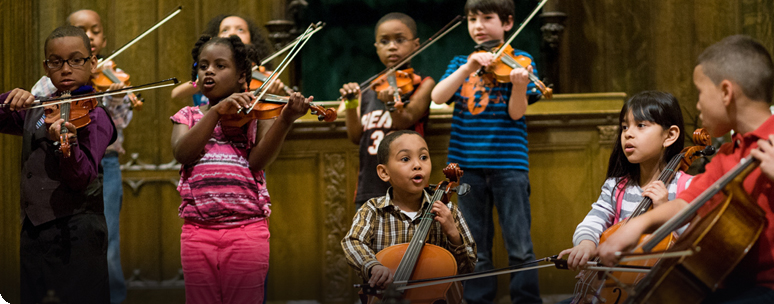Program Notes: Sonatas this ThursdayJoin us this Thursday, December 19 at 7 pm for another fabulous and free performance in our Sonata Series at the RISD Museum Grand Gallery. Our performers are Jesse Holstein, violin, along with Sakiko Mori, piano and Annalisa Boerner, viola with Aaron Jackson, piano. Enjoy these program notes by Jesse and Annalisa, which include the much needed explanation of the marking "conslugarocko" and an unlikely sports metaphor. Charles Ives (1874-1954) Violin and Piano Sonata No. 4, "Children's Day at the Camp Meeting". Composed in the fall of 1916, Charles Ives' Fourth Sonata for Violin and Piano paints scenes from the Children's Day service at Brookside Park in West Redding, Connecticut. Perhaps Ives himself can best introduce this work: There was usually only one Children's Day in these summer meetings, and the children made the most of it-often the best of it… The first movement was suggested by an actual happening: the organist's postlude practice and the boys' fast march to to joining in each other's sounds, the loudest singers singing wrong notes. Most of the second movement, quieter and more serious, moves around an old favorite hymn (Jesus Loves Me) while the accompaniment reflects the outdoor sounds of nature on those summer days: the west wind in the pines and oaks, the running brook. The third movement is the boys marching again-some of the old men would join in and march as fast-to "Shall We Gather at the River. One deliciously entertaining passage in the hymn-based second movement that Ives does not mention is marked with Ives' own onomatopoeic marking, conslugarocko. In between floating strains of the hymn Jesus Loves Me comes a truly wild interlude for the piano alone. It is meant to represent young boys sneaking away from the ongoing service to run down to the river to throw rocks and stones into the water. It is hard to miss. Olivier Messiaen (1908-1992) Louange à l'Immortalité de Jésus from Quatuor pour la fin du temps. Drafted into the French army at the outbreak of World War II, the composer Olivier Messiaen was captured by the Germans in May of 1940 and imprisoned at a POW camp in Görlitz, Germany. There he met a violinist, a cellist, a clarinetist, and some sympathetic guards that provided staff paper and a semi-secluded work space to compose. At Görlitz, Messiaen composed the eight movement Quatuor pour la fin du temps, or Quartet for the End of Time, for himself and his fellow prisoner-musicians. A deeply religious man, Messiaen himself wrote that the piece was inspired by the Book of Revelation, particularly Rev 10:1-2, 5-7: And I saw another mighty angel come down from heaven, clothed with a cloud: and a rainbow was upon his head, and his face was as it were the sun, and his feet as pillars of fire … and he set his right foot upon the sea, and his left foot on the earth …. And the angel which I saw stand upon the sea and upon the earth lifted up his hand to heaven, and sware by him that liveth for ever and ever … that there should be time no longer: But in the days of the voice of the seventh angel, when he shall begin to sound, the mystery of God should be finished …. The quartet received its premier in the camp for fellow prisoners and guards on January 15, 1941. Messiaen famously later said: "Never was I listened to with such rapt attention and comprehension." The final movement, Louange à l'Immortalité de Jésus, or Praise to the immortality of Jesus, is scored for violin and piano alone. Being in a camp surrounded by suffering and death, Messiaen's own words about the Quartet's concluding movement suggests how the composer contemplated his own mortality, and through his faith in God, transcended the prison walls at Gorlitz. It is especially aimed at second aspect of Jesus, Jesus the Man, the Word made flesh, immortally risen for our communication of his life. It is all love. Its slow ascent to the acutely extreme is the ascent of man to his god, the child of God to his Father, the being made divine towards Paradise. -Jesse Holstein Rebecca Clarke (1886-1979) Sonata for Viola and Piano (1919). I have a penchant for sports metaphors, so I can't resist the urge to tell you that on Thursday, at our Sonata Series concert, I get to play quarterback (or, at the very least, wide receiver). Rebecca Clarke's Sonata is a beautiful, part-Romantic, part-Impressionistic duo that features both viola and piano equally. Aaron (Jackson, pianist) and I toss stretches of melody back and forth, each taking turns at directing the play. Sometimes he's the offensive line, covering for me as I step back and make a long pitch (movement 1), or bolstering my sound for a quick quarterback sneak (movement 2). Sometimes I'm called upon to play wide receiver, running a route and playing a line that sets up or sets off his melody. Sometimes the piece doesn't really fit my tortured football metaphor, but it's a beautiful one to listen to nonetheless. In an orchestra, the viola often plays a supporting role – I'm that defensive lineman who doesn't attract attention until he misses his block. In a chamber group, I might even get to play tight end – though I will settle for kicker. I love playing those positions: I derive artistic and personal satisfaction from supporting my teammates, even in subtle ways. But, every once in a while, it's nice to hang out in the pocket (or, should I say, the RISD Museum Grand Gallery), and play quarterback. -Annalisa Boerner
|
